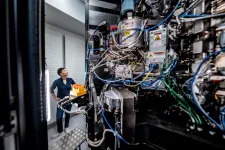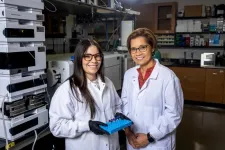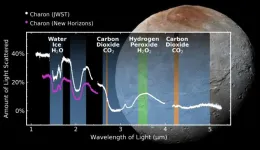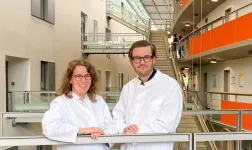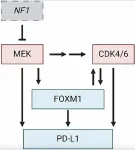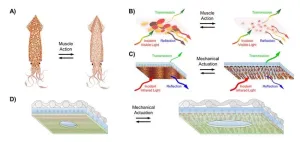(Press-News.org) FOR IMMEDIATE RELEASE
Using a sophisticated brain-imaging system, neuroscientists at Johns Hopkins Medicine say they have successfully reactivated a specific memory circuit in mice, causing them to seek out shelter when no shelter is actually present.
The researchers say the study, published Sept. 27 in Nature Neuroscience, advances understanding of how memories are structured in the mammalian brain. The findings could one day point to new ways of slowing down or preventing the memory loss that accompanies Alzheimer’s and other neurodegenerative diseases.
Specifically, the team found that stimulating neurons in two areas of mouse brains — the nucleus accumbens, also known as the brain’s “pleasure center” responsible for relaying dopamine-dependent behaviors, and the dorsal periaqueductal gray (dPAG), responsible for defensive behavior — reactivated a “spatial memory” and caused the mice to seek shelter.
“When we artificially reactivate those memory circuits in the brain, it triggers the mouse to do the same thing it did naturally, even without the fear stimuli that cause them to seek shelter to begin with,” says senior author Hyungbae Kwon, Ph.D., associate professor of neuroscience at the Johns Hopkins University School of Medicine.
The scientists say they aimed to map out which areas of the brain are responsible for navigating one’s surroundings, a high-level cognitive function among mammals, including humans. Thus, these experiments, which tested whether such cognitive brain functions can be replayed randomly, may have applications in understanding how other mammals behave, perceive and sense their environment.
In the new experiments, the researchers first allowed laboratory mice to explore their surroundings in a box with a shelter in the corner. The team placed a series of visual cues, including triangles, circles and stripes in different colors, to help the mice locate the shelter based on nearby landmarks. The mice acclimated to the area for seven minutes, entering and exiting the shelter.
Then, the researchers added a visual or auditory looming signal to spur them to seek shelter – also forming a spatial memory relative to their location and the visual cues.
To selectively tag shelter memory neurons, the researchers used a light-activated gene-expression switching system called Cal-light, which Kwon developed in 2017. Once the scientists identified these neurons in the nucleus accumbens, they switched on expression of the genes associated with them, reactivating the shelter-seeking memory in mice while also activating neurons in the dPAG.
In turn, the mice sought out the area of the box where the shelter had once been, when neither the original threat nor the shelter were present.
To get to this point, the researchers first selectively activated neurons in the nucleus accumbens and then, separately, in the dPAG, to see whether switching on neurons in just one area of the brain would cause this behavior.
“Surprisingly, we found that the mice did not seek out shelter when we activated neurons in the nucleus accumbens alone,” Kwon says. “Whereas switching on neurons in the dPAG caused the mice to react randomly, but did not guide them specifically to the area where they sought shelter before.”
“The Cal-light system allowed us to selectively tag a specific function in the brain, helping us to map out memory on a cellular level,” says Kwon.
Eventually, Kwon says this research could provide a foundation for reactivating or engineering memory circuits in people with Alzheimer’s.
“If we understand the macro-level structure of memory, then we may be able to develop more effective strategies to prevent or slow down neurodegenerative diseases using this method,” he says.
The researchers say they hope to understand brain-wide memory structure by selectively tagging and reactivating neurons with different functions in different areas of the brain that lead to other specific behaviors.
“Understanding how all of these memory circuits work together will help us understand brain function better,” he says.
Other researchers involved in the study are Kanghoon Jung, Sarah Krüssel, Sooyeon Yoo, Benjamin Burke, Nicholas Schappaugh, Youngjin Choi and Seth Blackshaw of Johns Hopkins; Myungmo An of the Max Planck Florida Institute for Neuroscience; and Zirong Gu and Rui M. Costa of the Zuckerman Mind Brain Behavior Institute at Columbia University and the Allen Institute.
Funding for this work was provided by the Max Planck Florida Institute for Neuroscience, a National Alliance for Research on Schizophrenia and Depression Young Investigator Grant and National Institutes of Health Grants R01MH107460, 5U19NS104649, K99 NS119788, DK108230 and DP1MH119428.
DOI: https://doi.org/10.1038/s41593-024-01770-9
END
New study: neuroscientists spark shelter-seeking response by reactivating memory circuit
Findings could spur new ways to study and treat human memory loss, including Alzheimer’s disease
2024-10-01
ELSE PRESS RELEASES FROM THIS DATE:
Wendy Connors named Hertz Foundation President, succeeding Robbee Kosak
2024-10-01
The Fannie and John Hertz Foundation, a nonprofit organization that funds, supports, connects and catalyzes the nation’s top PhD students in science and technology, today announced that Wendy Connors, currently its chief development officer, will begin as president on Jan. 1, 2025. Connors will succeed current president Robbee Baker Kosak, who will retire after almost 10 years in the role.
Appointed by the Hertz Foundation board of directors, Connors is the sixth president of the foundation and second woman to hold the position since it was founded in 1957. She brings more than 25 years’ experience as an accomplished nonprofit executive ...
A tool to enhance the taste and texture of sourdough and study the complexity of microbiomes
2024-10-01
When millions of people went into lockdown during the pandemic, they went in search of new at-home hobbies to help cure their boredom. Among them was making sourdough bread. In addition to being sustainable for its use of natural ingredients and traditional methods which date back thousands of years to ancient Egypt, it also is valued for its nutritional benefits. For example, studies have shown that sourdough contains more vitamins, minerals and antioxidants compared to many other types of bread. For people with mild sensitivities to gluten, sourdough bread can be easier to digest since much of the gluten is broken down during ...
Structure of a eukaryotic CRISPR-Cas homolog, Fanzor2, shows its promise for gene editing
2024-10-01
(MEMPHIS, Tenn. – October 1, 2024) A revolution in biomedicine is currently underway, driven by the application of genome engineering tools such as the prokaryotic CRISPR-Cas9. New genome editing systems continue to be identified in different organisms, adding to the potential toolbox for various therapeutic applications. Scientists at St. Jude Children’s Research Hospital studied the evolutionary journey of Fanzors, eukaryotic genome-editing proteins. Using cryo-electron microscopy (cryo-EM), the researchers provided insights into the structural divergence ...
St. Jude names M. Madan Babu, PhD, senior vice president and chief data scientist
2024-10-01
St. Jude Children’s Research Hospital today announced M. Madan Babu, PhD, FRS, as the institution’s first Chief Data Scientist, Senior Vice President for Data Science, and leader of the newly formed Office of Data Science. This $195 million research enterprise will have 115 new positions.
In his new role, Babu will bring new, advanced computing technologies and data science approaches to biomedical research. His team will also facilitate the integration of biological and biomedical ...
It all adds up: Study finds forever chemicals are more toxic as mixtures
2024-10-01
BUFFALO, N.Y. — A first-of-its-kind study has measured the toxicity of several types of per- and polyfluoroalkyl substances (PFAS), better known as “forever chemicals,” when mixed together in the environment and in the human body.
The good news: Most of the tested chemicals’ individual cytotoxicity and neurotoxicity levels were relatively low.
The bad news: the chemicals acted together to make the entire mixture toxic.
“Though they are structurally similar, not all forever chemicals are ...
SwRI-led team discovers carbon dioxide and hydrogen peroxide on Pluto’s moon Charon
2024-10-01
SAN ANTONIO — October 1, 2024 — A Southwest Research Institute-led team has detected carbon dioxide and hydrogen peroxide for the first time on the frozen surface of Pluto’s largest moon, Charon, using observations from the James Webb Space Telescope. These discoveries add to Charon’s known chemical inventory, previously identified by ground- and space-based observations, that includes water ice, ammonia-bearing species and the organic materials responsible for Charon’s gray and red coloration.
“Charon is the only midsized Kuiper Belt object, in the range of 300 to 1,000 miles in diameter, that has been geologically mapped, thanks ...
More clarity on hereditary colorectal cancer
2024-10-01
The genetic confirmation of a suspected diagnosis of "hereditary colorectal cancer" is of great importance for the medical care of affected families. However, many of the variants identified in the known genes cannot yet be reliably classified in terms of their causal role in tumor formation. Under the leadership of the University Hospital Bonn (UKB) and the University of Bonn, an international team of researchers has reassessed the medical relevance of a significant number of unclear variants and thus significantly ...
FOXM1 and PD-L1 in CDK4/6-MEK resistance in nerve tumors
2024-10-01
“We suggest that future therapeutic strategies targeting the oncogenic network of CDK4/6, MEK, PD-L1, and FOXM1 represent exciting future treatment options for MPNST patients.”
BUFFALO, NY- October 1, 2024 – A new mini review was published in Oncotarget's Volume 15 on September 30, 2024, entitled, “Linking FOXM1 and PD-L1 to CDK4/6-MEK targeted therapy resistance in malignant peripheral nerve sheath tumors.”
As highlighted in the abstract of this paper, malignant peripheral nerve sheath tumors (MPNSTs) are aggressive, Ras-driven sarcomas characterized ...
McMaster University researchers identify new therapeutic approach to preventing cancer from spreading to the brain
2024-10-01
Researchers at McMaster University have identified a new therapeutic approach to preventing cancer from spreading to the brain.
In a new study, published recently in the journal Cell Reports Medicine, researchers Sheila Singh and Jakob Magolan discovered a critical vulnerability in metastatic brain cancer, which they say can be exploited with new drugs to prevent spread.
Singh, a professor in McMaster’s Department of Surgery and director of the Centre for Discovery in Cancer Research, says brain metastases are becoming increasingly prevalent and are extremely fatal, with 90 per cent of patients dying within one ...
Squid-inspired fabric for temperature-controlled clothing
2024-10-01
WASHINGTON, October 1, 2024 – Too warm with a jacket on but too cold without it? Athletic apparel brands boast temperature-controlling fabrics that adapt to every climate with lightweight but warm products. Yet, consider a fabric that you can adjust to fit your specific temperature needs.
Inspired by the dynamic color-changing properties of squid skin, researchers from the University of California, Irvine developed a method to manufacture a heat-adjusting material that is breathable and washable and can be integrated into flexible fabric. They published their ...
LAST 30 PRESS RELEASES:
Autistic and non-autistic faces may “speak a different language” when expressing emotion
No clear evidence that cannabis-based medicines relieve chronic nerve pain
Pioneering second-order nonlinear vibrational nanoscopy for interfacial molecular systems beyond the diffraction limit
Bottleneck in hydrogen distribution jeopardises billions in clean energy
Lung cancer death rates among women in Europe are finally levelling off
Scientists trace microplastics in fertilizer from fields to the beach
The Lancet Obstetrics, Gynecology, & Women’s Health: Taking paracetamol during pregnancy does not increase risk of autism, ADHD or intellectual disabilities, confirms new gold-standard evidence review
Taking paracetamol during pregnancy does not increase risk of autism, ADHD or intellectual disabilities
Harm reduction vending machines in New York State expand access to overdose treatment and drug test strips, UB studies confirm
University of Phoenix releases white paper on Credit for Prior Learning as a catalyst for internal mobility and retention
Canada losing track of salmon health as climate and industrial threats mount
Molecular sieve-confined Pt-FeOx catalysts achieve highly efficient reversible hydrogen cycle of methylcyclohexane-toluene
Investment in farm productivity tools key to reducing greenhouse gas
New review highlights electrochemical pathways to recover uranium from wastewater and seawater
Hidden pollutants in shale gas development raise environmental concerns, new review finds
Discarded cigarette butts transformed into high performance energy storage materials
Researchers highlight role of alternative RNA splicing in schizophrenia
NTU Singapore scientists find new way to disarm antibiotic-resistant bacteria and restore healing in chronic wounds
Research suggests nationwide racial bias in media reporting on gun violence
Revealing the cell’s nanocourier at work
Health impacts of nursing home staffing
Public views about opioid overdose and people with opioid use disorder
Age-related changes in sperm DNA may play a role in autism risk
Ambitious model fails to explain near-death experiences, experts say
Multifaceted effects of inward foreign direct investment on new venture creation
Exploring mutations that spontaneously switch on a key brain cell receptor
Two-step genome editing enables the creation of full-length humanized mouse models
Pusan National University researchers develop light-activated tissue adhesive patch for rapid, watertight neurosurgical sealing
Study finds so-called super agers tend to have at least two key genetic advantages
Brain stimulation device cleared for ADHD in the US is overall safe but ineffective
[Press-News.org] New study: neuroscientists spark shelter-seeking response by reactivating memory circuitFindings could spur new ways to study and treat human memory loss, including Alzheimer’s disease

